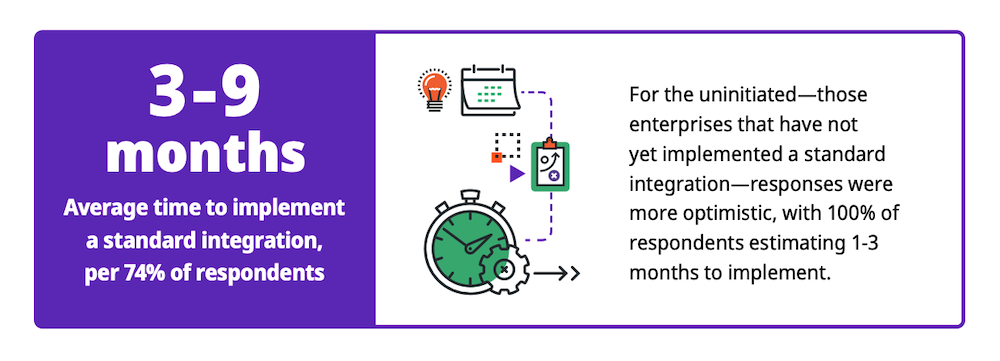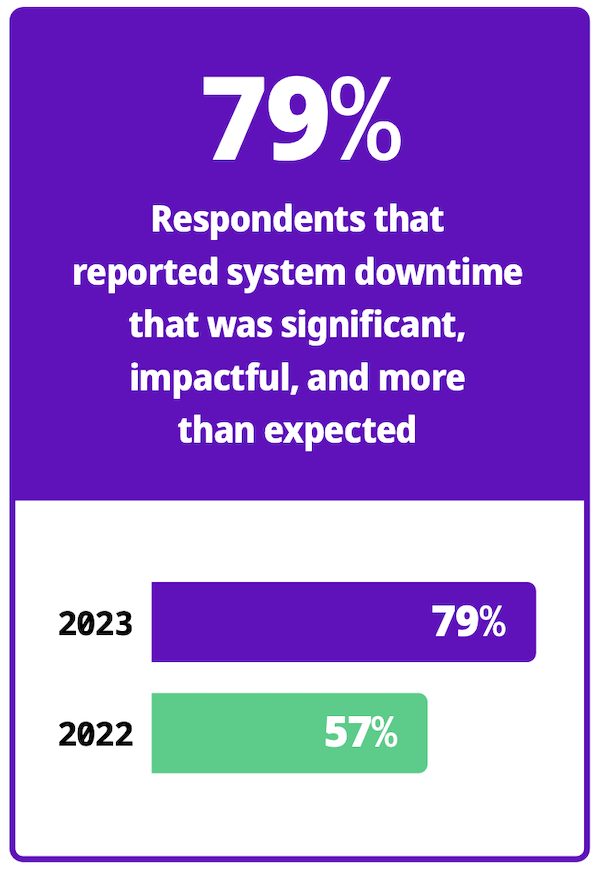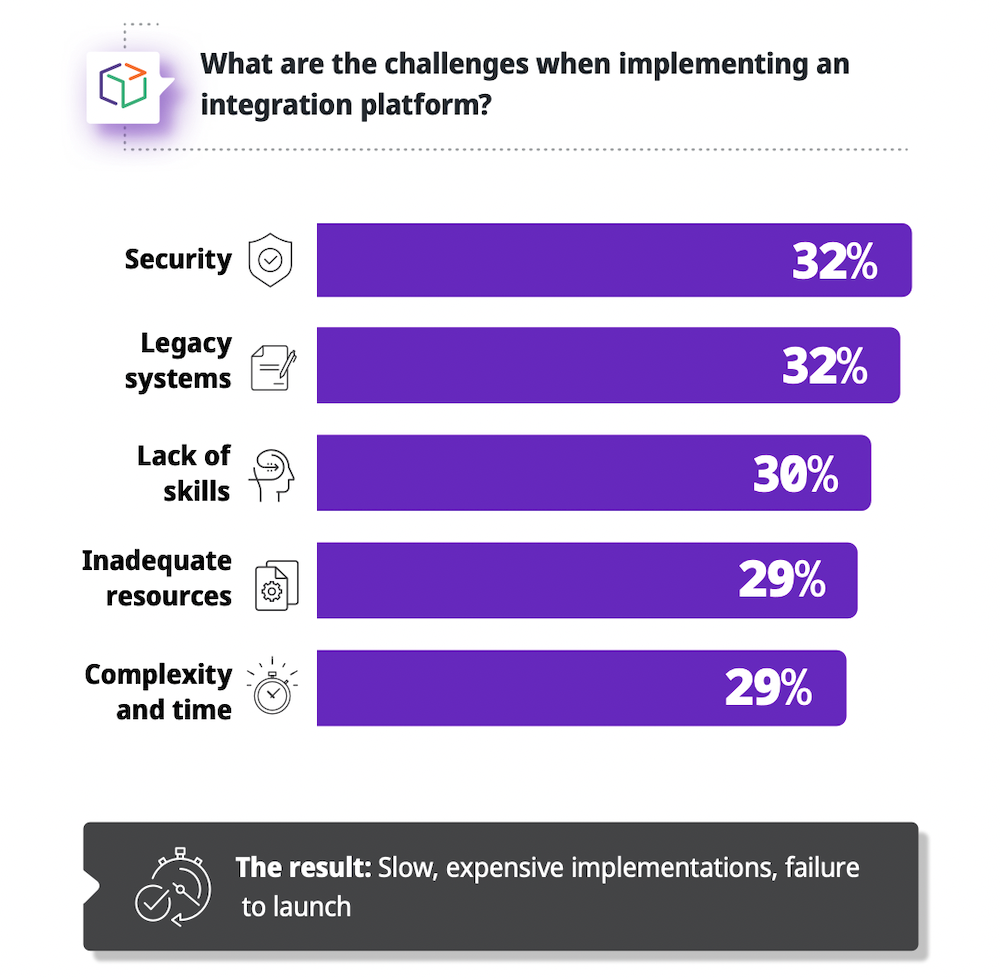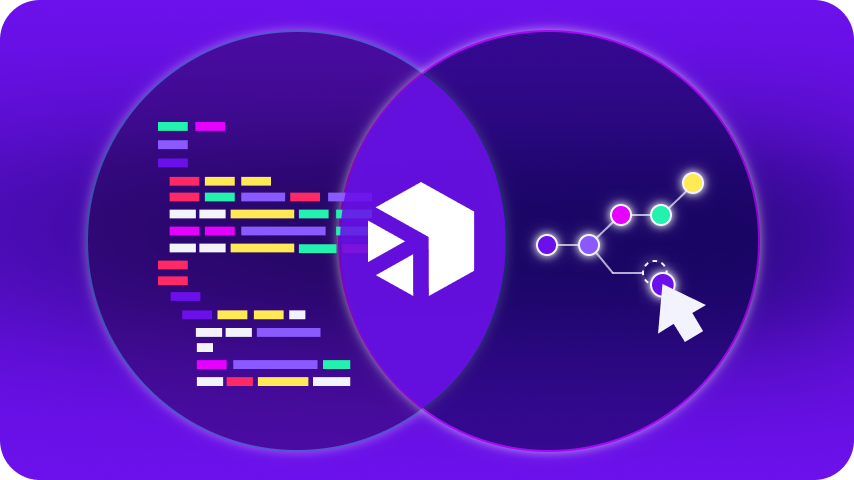May 30, 2023
In 2023, Digibee’s conducted its second annual annual State of Enterprise Integration survey, reaching out to one thousand CTOs, CIOs, system architects, and web developers in North America.
In this blog post series, we examine one of the top findings in the report, as ranked by your peers. Implementation time stood out as one of the biggest challenges when embarking on an IT digital transformation strategy. Many survey respondents said while their goal was accelerating digital transformation, integration implementation took much longer and was more complicated than expected.
The Challenge: Integration Implementation Time
Business leaders today understand that enterprise integration has become an industry standard. They know it’s necessary to adopt innovative technologies that accelerate digital transformation throughout the enterprise to ensure future success. That’s why most survey respondents (71%) are actively planning to adopt, supplement, or replace their integration technology in 2023 as part of their IT digital transformation strategy.
As business leaders start to follow their system integration project plan on how to accelerate digital transformation, however, many organizations are getting bogged down during the implementation process.
According to the Digibee 2023 State of Enterprise Integration Report, 100% of respondents who had not yet started implementing a standard integration, estimated that an implementation would take about one to three months to complete.
However, 74% of respondents who have already started down their digital transformation strategy roadmap, have discovered that the average time to implement a standard integration is between three and nine months – up to three times longer than expected.
How long does it take your team to implement a standard integration?
Digital Transformation and the Cost of Downtime
The High Price We Pay For Delays
Even the best laid digital transformation plans can be disrupted by many factors that lead to delays in integration implementation time. Delays can be caused by complex legacy systems, internal process limitations, IT backlogs, inadequate resources, and other unexpected factors, but the Digibee report states that the biggest impediment to a faster implementation is system downtime.
Downtime often occurs during integration implementation when organizations currently rely on outdated technology, whether they’re on-premises, complex in-house systems, or legacy systems. Those organizations with the most challenging environments to convert often face the longest integration delays.
 Delaying a software migration project plan can have costly results. Unexpected delays such as downtime can quickly lead to expensive disruptions with widespread effects that reduce the acceleration of digital transformation.
Delaying a software migration project plan can have costly results. Unexpected delays such as downtime can quickly lead to expensive disruptions with widespread effects that reduce the acceleration of digital transformation.
Information Technology Intelligence Consulting’s report, The Hourly Cost of Downtime, states that “The cost of downtime has increased significantly for 90% of SME and large enterprises, with 44% reporting that a single hour of downtime could potentially cost over $1M.”
In Digibee’s 2023 report, a majority (79%) of respondents said system downtime during integration had a significant impact on their business and was a much bigger disruption than expected. The number of respondents who experienced unexpected downtime was significantly higher than last year’s report, which was 57%.
While more than three-quarters of respondents were left dealing with unplanned downtime when implementing their system integration project plan, downtime isn’t the only factor impeding software migration project plans, and cost isn’t always the biggest factor either. In fact, while budget topped the list of integration challenges in last year’s Digibee report, it wasn’t even in the top five challenges for 2023.
Other challenges facing business leaders this year include security issues, legacy systems, a lack of skills and inadequate resources within organizations, as well as the increasing complexity and time it takes to implement and maintain system integrations. This often results in additional investments in maintenance and training. All of these issues can lead to slower, more expensive implementations that can reduce return on investment (ROI), which ultimately affects the overall digital transformation ROI.
With so many challenges to overcome, it’s no surprise that over 70% of leaders surveyed are actively planning to adopt, supplement, or replace their integration technology in 2023.
Overcoming Implementation Time Challenges with iPaaS
On paper, a digital transformation plan may seem simple, but in reality, all of the variables involved in a typical migration project plan can make the implementation time much longer and more complicated than expected. Ineffective integrations impede profitability, so business leaders must have a solid IT digital transformation strategy and a system integration project plan for the implementation process.
The most effective way to ensure the successful acceleration of digital transformation is to take advantage of modern technology with an enterprise integration platform-as-a-service (iPaaS) environment. An iPaaS with drag-and-drop interfaces can make implementing a software integration project plan quicker and easier.
Digibee provides a fast and streamlined IT integration experience. Digibee’s easy-to-use iPaaS is a cloud-native, enterprise-ready integration platform that accelerates time-to-value, mitigates risks, and helps reduce IT costs. For example, Digibee integrated a secure iPaaS e-commerce platform for global shoe retailer Payless Shoes across more than 400 stores in 15 countries in less than 30 days. How’s that for fast and easy? The iPaaS system easily handles seasonal spikes for the busy retailer, and provides better efficiency, transparency and security across the retail enterprise, despite each country having different fiscal and legal requirements.
Accelerating digital transformation can be done quickly and successfully, as long as you take the right approach with an effective digital transformation strategy roadmap supported by iPaaS technology.
Get the full story on what’s changed and how your peers are mobilizing enterprise integration in 2023. Download your free Digibee 2023 State of Enterprise Integration Report today for all of the survey results and the analysis.













